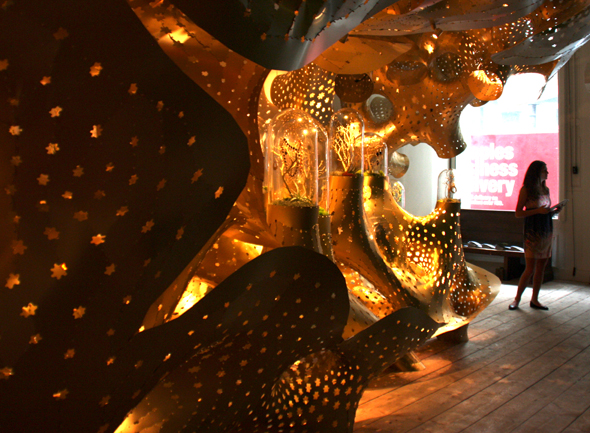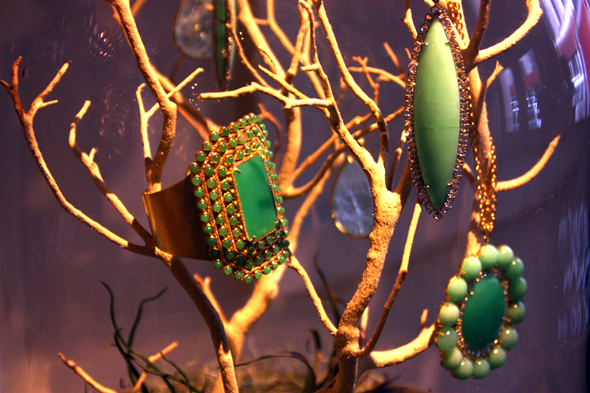
Architecture and fashion are typically considered two separate forms of design with little to do with each other, but Faris Al-Shathir is working to change that notion.
Al-Shathir is director and co-founder of BOFFO, a non-profit organization that works to convert empty, unused spaces in New York City into art. This fall, the organization is sponsoring five competitions and a series of exhibits to connect high-profile fashion designers with architects to collaborate on a Tribeca pop-up store — a previously dark, abandoned space transformed into a glitzy retail shop, teeming with people engaged as much in taking photographs as shopping.
Right now, the space at 50 Walker St. is the result of a partnership between jewelry designer Irene Neuwirth and architect Marc Fornes under his label, TheVeryMany. Their version of the pop-up store, a forest of jewelry displayed behind softly illuminated glass cases, will last until October 12. Coming up in late October is fashion of unusual fabrics, including gold foil and vintage parachutes.
The first exhibit, a collaboration between fashion designer Nicola Formichetti and Gage/Clemenceau Architects, featured a space that started with plants and television screens and morphed into a room of spikes made entirely of mirror edges and projected lights.
Veronica Acosta, a student at Parsons School of Design, visited the store designed by Gage/Clemenceau on the last day it was open in September. She said she thought the first exhibit was “crazy.”
“You step in, and the first part is normal, and then you move into the crazy part,” she said on the sidewalk outside the store, reflecting on what she’d just seen.
Acosta said the exhibit made her think about some ways she and other students at Parsons can collaborate on different ideas of design. “We have fashion students and architecture students and that connection is missing,” she said. “We don’t collaborate within the school, but this is something to bring back and share with other students.”
More than 350 architects applied to work with all five designers, Al-Shathir said. The prize is the opportunity to collaborate with a high-profile designer and a $20,000 stipend. “It’s a really good opportunity to build in New York, which is rare if you’re an architect,” Al-Shathir said. “It also makes a new client relationship, someone you could work with in the future.”
One of those applicants was Marc Bailly, a partner in the architecture firm of Gage/Clemenceau Architects, previously known for their work in residential areas through the city. He said he and partner Mark Gage had heard of the BOFFO competition previously. Since this was the second year of the competition, and there was a particular fashion designer they were dying to work with, they entered — and won.
“When the opportunity came to do the project with Nicola [Formichetti], we jumped at it,” he said. “The five designers are all great, but Nicola is really crazy. His stuff is just all over the place. It fits really well into our aesthetic, of this over-the-top and over-saturated aesthetic.”
Formichetti is best known as the creative director for the French fashion house MUGLER, as well as a frequent collaborator with performing artist Lady Gaga. More than 150 architects submitted their bid to work with him, but he eventually picked Gage/Clemenceau and their proposed design of mirrored spikes and lights.
Bailly said despite Formichetti’s reputation for wild designs, he was down-to-earth and easy to work with. “We kind of welcomed the challenge,” Bailly said. “We had this immersive environment with the mirrors and the robotic lights, very multifaceted. It was a highly collaborative effort. Part museum, part retail and part entertainment.”
The competition provides a unique opportunity for designers to flex their creative muscles while bringing awareness to the techniques that are new and cutting-edge, Bailly said.

“Before, fashion designers might think to hire a conventional architect,” he said. ‘Now, we can create a design to fit their brand. It opens up opportunities for more talent.”
Al-Shathir said the competition targeted fashion and architecture because of the unusual dynamic between architecture’s permanence and fashion’s constant evolution.
“We noticed there being a lack of diversity and excitement in the retail component of fashion,” he said. “We also had a great number of fashion designers who had never had the opportunity to take that step. You really love the idea and the pop and celebrity culture and the architecture industry can really play off that and create some excitement.”